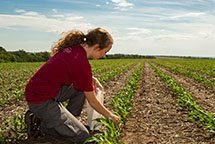Field Focus: Understanding Crop Challenges This Summer
Jun 19, 2024

Understanding Rapid Growth Syndrome and Crop Challenges This Summer
John McNamara, Seed Technical Advisor
As summer progresses, many growers are noticing unusual patterns in their crops, particularly corn and soybeans. Here we will dive deeper into the current challenges faced by farmers and offers insights into managing these conditions effectively.
Rapid Growth Syndrome in Corn
Rapid Growth Syndrome (RGS) is a common issue observed in corn fields, especially when plants experience a growth spurt under specific weather conditions. Here's a closer look at what causes RGS and how to manage it.
Symptoms and Causes:
Soybeans are also facing their own set of challenges this season, primarily due to weather conditions affecting their development.
Current Stage and Growth:
With temperatures soaring into the 90s, special care is needed when applying post-emergence herbicides.
Application Tips:
The mild winter and warm spring have led to increased insect populations, posing significant risks to crops.
Key Insects:
John McNamara, Seed Technical Advisor
As summer progresses, many growers are noticing unusual patterns in their crops, particularly corn and soybeans. Here we will dive deeper into the current challenges faced by farmers and offers insights into managing these conditions effectively.
Rapid Growth Syndrome in Corn
Rapid Growth Syndrome (RGS) is a common issue observed in corn fields, especially when plants experience a growth spurt under specific weather conditions. Here's a closer look at what causes RGS and how to manage it.
Symptoms and Causes:
- Corn plants that have emerged normally can develop twisted and yellowing upper growth as they reach the 4th to 5th leaf stage.
- This condition occurs after periods of stress (hot, dry, cool, wet) followed by high temperatures (90+°F during the day, 70+°F at night) and adequate rainfall or irrigation.
- Rapid cell elongation and division cause the upper leaves to become twisted and tied together.
- Typically, less than 20% of plants are affected.
- As temperatures normalize, the twisted leaves will unfurl within 4-5 days.
- The newly exposed leaves may show a “yellow flash” due to lack of chlorophyll but will green up within 2-3 days.
Soybeans are also facing their own set of challenges this season, primarily due to weather conditions affecting their development.
Current Stage and Growth:
- Most soybean plants are between the V2 and V3 stages, standing 4-6 inches tall with 2-3 trifoliates.
- Under normal conditions, soybeans develop a new trifoliate every 5-7 days until V6, after which growth accelerates.
- Many stands are thinner and more uneven than usual, often due to excessive moisture during early growth stages.
- Some fields have required replanting due to poor emergence.
- Rapid growth after early-season stress can cause puckered or crinkled leaves.
- Unlike corn, soybean leaves have a broad U-shaped marginal meristem that can cause irregular leaf surfaces under stress.
With temperatures soaring into the 90s, special care is needed when applying post-emergence herbicides.
Application Tips:
- Herbicide absorption is higher during heat, and plants under stress are less capable of metabolizing the chemicals effectively.
- Spray during cooler parts of the day, such as early morning or evening, to reduce the risk of crop injury.
- Consider switching to less volatile herbicides or delay application if high temperatures persist.
The mild winter and warm spring have led to increased insect populations, posing significant risks to crops.
Key Insects:
- Thistle caterpillars, grasshoppers, and European Corn Borers are particularly problematic this year.
- Grasshoppers are emerging in high numbers, especially around field margins and ditches.
- Early intervention is crucial; control grasshoppers when they are small (nymph stage).
- Insecticides such as Indigo, Warrior II, and Asana are effective and can be applied both by ground and aerial methods.